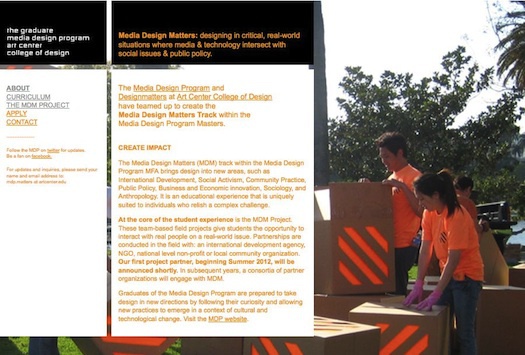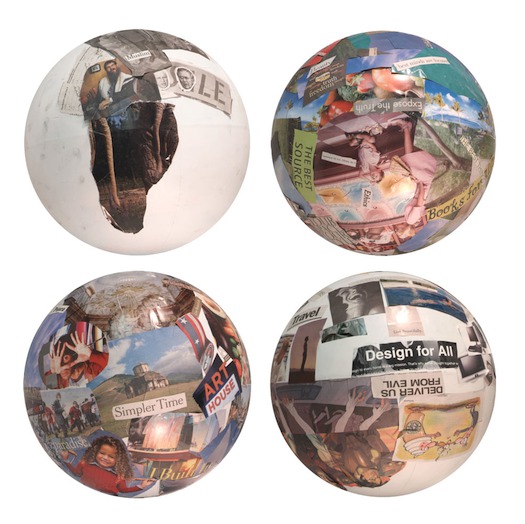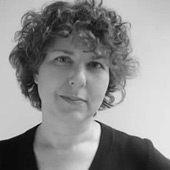
The burgeoning discipline of social design is supported by a growing number of educational programs where students learn to create products, systems and strategies for communities in need. A veteran among them is the 10-year-old Designmatters initiative at Art Center College of Design. Led by Mariana Amatullo, Designmatters cuts across university departments to allow a mix of undergraduates, graduates and faculty the chance to tackle local and global problems, including the high incidence of cervical cancer among Southern California Latinas and limited access to water afforded to Peruvian and Chilean slum dwellers.
Also burgeoning in design education is the study of media and technologies that reshape the way information is packaged and communicated. For 11 years, Art Center’s Media Design Program, a graduate-level research-oriented program chaired by Anne Burdick, has trained students to use design practice and theory to craft revealing new ways of representing — and reshaping — history, economics and culture.
Now, both programs are coming together in the new Media Design Matters track at Art Center. Beginning in May 2012, 10 graduate students from a range of disciplines will work with three core faculty in the Media Design Program to apply communications strategies to concrete social problems. Fieldwork will be undertaken in partnership with external organizations, beginning with the U.S. Fund for UNICEF and UNICEF’s Tech Innovation Team, a group that excels in adapting communications technology, such as Rapid SMS, to improving children’s health and education.
The first Media Design Matters class will spend part of its time in UNICEF’s field office in Uganda on a project that will be determined by the students, faculty and Innovation Team partners. (Five of the 10 MDM students have already begun the program for intensive design training. They will be joined by the rest of the class in the summer term beginning April 2012.)
In the midst of energetic work of the new academic year, Burdick and Amatullo paused to speak to Change Observer about the nascent program.
Change Observer: Together you’re combining a graduate program in new media and communications with an initiative that takes design students and others into the field to solve social problems. What inspired you to join forces?
Anne Burdick: The work we do in Art Center’s Graduate Media Design program is difficult to categorize, and we like it that way. That’s because we’re exploring new practices in design. Our approach is to create an environment that has openness and rigor to see what emerges. So many things in the world are in flux on every level: economic, environmental, technological. The way in which the practice of design responds to that is of deep interest to us. It is through that interest that we’re coming to the Media Design Matters track. We’ve worked with Mariana and Designmatters in the past, working together with UNICEF’s Tech Innovation team, which is headquartered in New York and collaborates closely with UNICEF country offices. Not only did we have successful outcomes on such projects as a digital storytelling program for youth journalists in the Philippines and Caribbean (From Hi-Fi to Lo-Fi: Sharing Digital Stories in the Developing World), but the collaboration parlayed into other things. Each summer, one of our students is a Designmatters fellow interning with the Tech Innovation team. That gave us an opportunity to do more collaborative projects and also build on embedded relationships.
Mariana Amatullo: Designmatters is approaching its tenth anniversary and has had amazing evolution and growth. It has been especially rewarding to build and sustain partnerships with organizations such as UNICEF that allow our students to experience truly immersive opportunities that take their work way beyond the studio’s walls. Last summer’s Designmatters fellow, Dustin York, helped UNICEF push forward a child-friendly technology platform that is being implemented as we speak in Africa. But we haven’t had the opportunity for long, deep engagements with graduate education before — a platform to engage with students and faculty for more than one or two academic terms. Media Design Matters will help us to push this educational model to a whole new level.
There’s also alignment in our understanding that the world is messy, and that design is not necessarily about solving problems but also a process of discovery. When you’re involved in social issues, there is not necessarily one solution. We think the program is going to bring that questioning and participatory framework to a level that is exciting.
Change Observer: What academic models have you followed in establishing Media Design Matters?
Burdick: There are precursors within our department, such as Superstudio, a curriculum that was initiated by Andy Davidson and Brenda Laurel in 2001 and ran for seven years. Students started in their first semester engaging with a group of people with a set of bounding terms. For instance, in 2004–05, it was looking at 6-year-old boys within the context of “manliness,” media messaging and social intelligence. Students worked with kids, engaged in design research and developed ideas for products, services and systems. Then they took the ideas back to the community to do a loose form of user testing and intervention and develop some sort of outcome. In this example, it was a toy called Blux that allowed the boys to work with one another to harness solar and biomechanical energy. The prior year we had looked at tweens and stress. In 2006–07, in a project called Passing on the Future, we worked with families with teenagers to understand generational differences in attitudes toward nature and the future. Our goal was to find a strategy to effect change around global warming. In the initial research phase, students created "probes" — activity kits that allowed the participants to share information about their lives through metaphor and making. With MDM, we plan to continue this approach of using design as a tool to engage with people.

Spheres representing attitudes about the future — part of Media Design's Superstudio program.
Siblings or peer projects would be Bill Gaver’s groundbreaking work with the Presence Project. Or the work of Rama Gheerawo at the Helen Hamlyn Centre for Design, at the RCA. We also have a number of colleagues at the University of Helsinki engaging in human-centered research driven by design who spent time studying our methods in the Superstudio course.
Change Observer: Your curriculum involves individual and group work. What’s the thinking behind that?
Amatullo: A lot of transdisciplinary studio models bring together different departments and organize students working in teams around an issue. I think that the method really pushes questions of what collaboration means both within and beyond the academic institution. Also, individual work emerges from collective and shared-knowledge processes. For example a community laundry center that came out of Designmatters Safe Agua project in Chile was the idea of a single designer. Other outcomes were collective.
Burdick: The first semester of Media Design Matters, which takes place in summer, is about getting up to speed with background, history, ethics, design and technology. Students work locally, engaging with people and organizations so they have some experience before the project launches. In the Fall they work as a team for their first trip to the field, the length of their stay to be determined with our partner but also with the students and faculty. Designing the research will be a part of their education. In the third and fourth term, students may go back to individual work, depending on what they discover in the field and where they want to intervene. At that point they’ll be asking themselves: Who do I want to be as a designer? A creative technologist? A social entrepreneur? A Ph.D. in anthropology? Each one will take that experience and build something out of it unique to his or her own interests and career path. These projects can be conducted either by teams or individuals. Some might write papers. Some might design a new service and seek venture capital. Some might continue to work directly in the field. Some might want to duplicate the project with a different community to understand what happened with the design of the research. That’s where it opens up to a much broader experience with a range of outcomes.
Change Observer: Whom do you consider the ideal student for such a program?
Burdick: It’s going to be students from a broad range of backgrounds. We might be recruiting people out of the social sciences or healthcare or business or computer science who decide they want to become designers that work in the field. Some of those people will have very little design background and so they can enter our three-year path. They’ll have one year of additional coursework to get them up to speed. Students who are already designers can enter the regular two-year path and go straight into the MDM curriculum. But you know these designers need to be prepared to walk the walk. This isn’t for people who want to do pro-bono work designing logos for nonprofits. It’s for people who want to be face-to face with real people, finding common ground in situations that can be quite overwhelming because the levels of unfamiliarity and unpredictability might get pretty complicated. First-hand experience is at the heart of this.
Amatullo: I would add that our vision is to partner with those who align with our values and embrace technology but are also approaching issues that are emerging, not defined. We’re interested in working with UNICEF because they’re addressing systems issues of global technology and platforms for human development in a new way. With every partner, we’re going to be looking for that emerging knowledge. Students are coming into the program to be up to that challenge.
Burdick: The program requires seriously courageous risk-takers. We have five of our first cohort of ten. These are people who have entered the three-year path. We have someone coming out of the Kaiser Innovation Unit in Northern California. We have someone with a degree in social justice who is a photographer. There is also someone who developed a platform for gathering an aural history of New Orleans. He has no design training; his degree is in urban studies. We believe there’s such a great need for people who have these mixes of approaches and skills and also there is great opportunity to innovate at the intersection of these mixed perspectives.
Change Observer: What do you expect from the design students who will be entering the two-year path next year?
Burdick: I expect that we will find designers who have found the isolation of the studio not to be enough to satisfy their sense of adventure. Designers loo king for direct impact in the world. Also designers who want to take an alternative path as a designer —to be surrounded by peers from other fields, from the development world, from the social sciences. Having a job at the U.N. or spending five years in rural Africa is an extraordinary proposition, and one that is relatively new to design.
Change Observer: How is the economy affecting your recruitment efforts?
Burdick: The number of applicants rises every year but the thing that has been affected is students’ ability to get loans. Art Center has made raising money for scholarships a top priority and they have made great headway. One of the nice things about the Media Design Matters track is that it’s a 15-month engagement. Students start in May for the summer term and end the following summer in August, so they get out in under two years. Bearing in mind the real economic hardship everyone is experiencing, this is a way to make a significant career change efficiently.
Change Observer: A concern among social design educators is how to bring continuity to projects undertaken in the field when student participants rotate in and out in a few years, if not months. How do you hope to build continuity into the projects you institute?
Burdick: That is a key issue for us and an integral question within this kind of education. Ideally the work will be built from the ground up, meaning co-created directly with the community. But also, in their thesis work, our students will be taking the work another generation further. It’s likely that some of the students may even decide to come back and work with the Innovation lab after graduation. That’s what we experienced with students who became Designmatters fellows at UNICEF. There will be continuity from a pedagogical standpoint in that all students who graduate from this track will have the same “learning outcomes,” regardless of the specific project they work on. Graduates will understand all the factors that contribute to doing this kind of work, in addition to hands-on work with the community. This includes collaborating with a broad range of stakeholders, negotiating governmental institutions and funding bodies. We also deploy communication tools and technologies to greatest effect using the resources and infrastructure at hand.
Amatullo: We have an opportunity not just at Art Center, but in the design education community overall, to think about the body of knowledge that starts building in this area where we are working. I think that’s exciting.
Burdick: Your question offers a good segue to the role of faculty in Media Design Matters. Our faculty will be building relationships doing this kind of work, and the outcomes from the projects are going to be their research too. We are also open to identifying projects that integrate into their ongoing work. Elizabeth Chin is an anthropologist who has been working with children in Haiti for a long time. Chris Csikzentmihalyi, the former director of the Center for Future Civic Media at MIT, has been working with communities dealing with fracking in rural Pennsylvania and the Midwest, developing platforms that empower them to take action in their own behalf.
Amatullo: And Sean Donahue is also an example of a designer doing a lot of work with user-centered design research with communities in California around health issues, disaster preparedness and crisis management.
Burdick: That part — the faculty-led research — is an important piece in terms of ongoing commitment to socially engaged design within our department. In addition to the MDM projects, we’re also building research in this area with the kinds of faculty we’ve chosen to spearhead this curriculum. It’s important to us that they’re also researchers in this domain.

